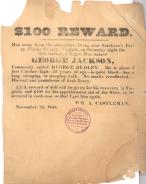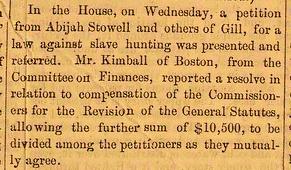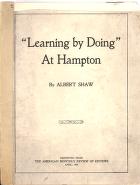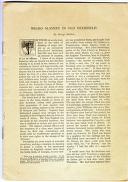|

Frederick Douglas refused passport

"$100 Reward"

"Legislature- slave hunting petition"

Slave gives talk in Northfield

Bill of sale for slave named Kate

Pages from Elijah Williams (Old Soldier's) account book, Vol. 2

Pages from Rev. Jonathan Ashley's account book

"Learning By Doing At Hampton"

"The African Slave Trade"

"The Slave Trade - The Administration"

"News Items"- Mass. Petitions to abolish slave-hunting

"Union and Liberty"

"The American Anti-Slavery Almanac for 1838"

"Negro Slavery in Old Deerfield"
|
Summary and Objective
After studying slavery and the Abolitionist Movement in the United States, students will research their impact in Western Massachusetts. Students will understand that primary documents are important resources for researching historical events.
Teaching Plan
Step 1.
Pre-activity: Design a set of focus questions for pairs of students to answer during their research (consult the links below, if desired). Questions to consider: When did the first African slaves arrive in Massachusetts? Explain the official policy towards slavery in the New England Confederation. Describe the early Massachusetts slave trade mid-1600's to mid-1700's. How did the Christian populace in Massachusetts rationalize slavery? State various regulations that were designed to control the slave population.
Step 2.
Students working in pairs will examine primary documents relating to slavery and the Abolitionist Movement. All students will view the following primary documents: Frederick Douglas refused passport; "$100 reward"; "Legislature-slave hunting petition"; Slave gives talk in Northfield; Bill of sale for slave named Kate; Pages from Elijah Williams account book, Vol.2; Pages from Rev. Jonathan Ashley's account book; and "Learning By Doing At Hampton." Groups will need to respond in writing to the following question: Based on the primary documents you have read, what was the overall feeling of slavery and anti-slavery in Western Massachusetts? Explain your reasoning, and cite two documents for each belief that support your conclusion.
Step 3.
Next, pairs will be assigned one of the following documents: " The African Slave Trade"; " The Slave Trade -The Administration"; " News items" - Mass. Petitions to abolish slave-hunting; "Union and Liberty"; various pages from "Negro Slavery in Massachusetts"; various pages from "The American Anti-Slavery Almanac 1838"; or "Negro Slavery in Old Deerfield." Pairs will need to answer the following questions: Does your document reflect the beliefs of the Abolitionist movement, yes or no? Cite two specific examples to support your explanation.
Step 4.
Pairs will need to answer all questions, summarize their findings and state what they learned by using primary documents. This will take the form of a 1 to 2 page paper, typed at a 14 font. Also, they must be prepared to discuss their finding in a class forum.
Step 5.
Wrap-up activity: Students will hand in their papers at the beginning of class. Next, they will discuss their findings and what they learned in an oral discussion.
Step 6.
Optional post-activity: Students will search the web sites below to find additional information on slavery and abolition.
|




